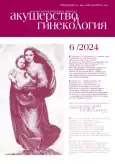Clinical case of hemorrhagic stroke in a pregnant woman
- Authors: Ziganshin A.M.1, Tagirov M.R.1, Dikke G.B.2
-
Affiliations:
- Bashkir State Medical University, Ministry of Health of Russia
- F.I. Inozemtsev Academy of Medical Education
- Issue: No 6 (2024)
- Pages: 170-176
- Section: Clinical Notes
- Published: 21.06.2024
- URL: https://journals.eco-vector.com/0300-9092/article/view/634457
- DOI: https://doi.org/10.18565/aig.2024.136
- ID: 634457
Cite item
Abstract
Relevance: Stroke is a potentially life-threatening condition for the patient. Hemorrhagic stroke due to the rupture of an arteriovenous malformation in pregnant women is a rare pathology, and its description is of practical interest.
Case report: A 26-year-old female patient N., primipara, at 30 weeks gestation, was transported by air ambulance with signs of haemorrhagic stroke. According to the case conference, the patient underwent the skull trepanation on the left side and ventriculostomy taking into account intraventricular haemorrhage with the development of ventricular tamponade, cerebral edema confirmed by CT scan; the next day the patient had bifrontal decompressive skull trepanation, excision of arteriovenous malformation, removal of hematomas of the right, left lateral and third ventricles. The pregnancy was complicated by chronic fetal hypoxia, with a tendency to progression, stage 2 placental disorder, low water supply, stage 2 anemia; the pregnancy ended at 32 weeks with operative delivery and birth of a live female child, weight 2140 g, height 46 cm with a score of 6–7 according to the Apgar scale. The postoperative period was uneventful. The patient was treated subsequently in accordance with the underlying disease and recommendations of narrow specialists regarding the persisting neurologic deficit and liquorodynamic disorders.
Conclusion: Hemorrhagic stroke due to the rupture of an arteriovenous malformation in a primigravida at 30 weeks is an extremely rare condition with a high risk of death but can be treated in case of timely diagnosis and emergency medical care. Timely neurosurgical treatment and subsequent operative delivery resulted in a favourable pregnancy outcome.
Keywords
Full Text
About the authors
Aidar M. Ziganshin
Bashkir State Medical University, Ministry of Health of Russia
Author for correspondence.
Email: zigaidar@yandex.ru
ORCID iD: 0000-0001-5474-1080
Dr. Med. Sci., Associate Professor at the Department of Obstetrics and Gynecology, Institute of Additional Professional Education
Russian Federation, UfaMaksim R. Tagirov
Bashkir State Medical University, Ministry of Health of Russia
Email: maxim.tagirov00@mail.ru
ORCID iD: 0000-0003-3887-1330
student
Russian Federation, UfaGalina B. Dikke
F.I. Inozemtsev Academy of Medical Education
Email: galadikke@yandex.ru
ORCID iD: 0000-0001-9524-8962
Dr. Med. Sci., Professor at the Department of Obstetrics and Gynecology with the Course of Reproductive Medicine
Russian Federation, St. PetersburgReferences
- Miller E.C., Leffert L. Stroke in pregnancy: a focused update. Anesth. Analg. 2020; 130(4): 1085-96. https://dx.doi.org/10.1213/ANE.0000000000004203.
- Katsafanas C., Bushnell C. Pregnancy and stroke risk in women. Neurobiol. Dis. 2022; 169: 105735. https://dx.doi.org/10.1016/j.nbd.2022.105735.
- Баяндурян Э.А., Самбурова Н.В., Аничкова Е.В., Шкода А.С., Бицадзе В.О. Этиопатогенетические факторы риска развития инсульта у беременных. Акушерство, гинекология и репродукция. 2019; 13(3): 217-26. [Bayanduryan E.A., Samburova N.V., Anichkova E.V., Shkoda A.S., Bitsadze V.O. Etiopathogenetic risk factors for stroke in pregnant women. Obstetrics, Gynecology and Reproduction. 2019; 13(3): 217-26 (in Russian)]. https://dx.doi.org/10.17749/2313-7347.2019.13.3.217-226.
- Краснопольский В.И., Логутова Л.С., Ахвледиани К.Н., Травкина А.А., Лубнин А.Ю., Петрухин В.А., Власов П.Н., Мельников А.П., Будыкина Т.С., Коваленко Т.C. Геморрагический инсульт и беременность. Акушерство и гинекология. 2016; 2: 55-62. [Krasnopolsky V.I., Logutova L.S., Akhvlediani K.N., Travkina A.A., Lubnin A.Yu., Petrukhin V.A., Vlasov P.N., Melnikov A.P., Budykina T.S., Kovalenko T.S. Hemorrhagic stroke and pregnancy. Obstetrics and Gynecology. 2016; (2): 55-62. (in Russian). Obstetrics and Gynecology. 2016; (2): 55-62 (in Russian)]. https://dx.doi.org/10.18565/aig.2016.2.55-62.
- Wu P., Jordan K.P., Chew-Graham C.A., Coutinho T., Lundberg G.P., Park K.E. et al. Temporal trends in pregnancy-associated stroke and its outcomes among women with hypertensive disorders of pregnancy. J. Am. Heart Assoc. 2020; 9(15): e016182. https://dx.doi.org/10.1161/JAHA.120.016182.
- Зиганшин А.М., Кулавский В.А., Вашкевич А.Г. Беременность и эпилепсия. Российский вестник акушера-гинеколога. 2019; 19(3): 43-8. [Ziganshin A.M., Kulavskiĭ V.A., Vashkevich A.G. Pregnancy and epilepsy. Russian Bulletin of Obstetrician-Gynecologist. 2019; 19(3): 43-8 (in Russian)]. https://dx.doi.org/10.17116/rosakush20191903143.
- Игнатьева В.И., Вознюк И.А., Шамалов Н.А., Резник А.В., Виницкий А.А., Деркач Е.В. Социально-экономическое бремя инсульта в Российской Федерации. Журнал неврологии и психиатрии им. С.С. Корсакова. Спецвыпуски. 2023; 123(8-2): 5-15. [Ignatyeva V.I., Voznyuk I.A., Shamalov N.A., Reznik A.V., Vinitskiy A.A., Derkach E.V. Social and economic burden of stroke in Russian Federation. S.S. Korsakov Journal of Neurology and Psychiatry. 2023; 123(8-2): 5-15. (in Russian)]. https://dx.doi.org/10.17116/jnevro20231230825.
- Camargo E.C., Singhal A.B. Stroke in pregnancy: a multidisciplinary approach. Obstet. Gynecol. Clin. North Am. 2021; 48(1): 75-96. https://dx.doi.org/10.1016/j.ogc.2020.11.004.
- Шаповалова О.А., Новикова В.А., Оленев А.С. Гестационно обусловленные предпосылки для материнского нарушения мозгового кровообращения. Практическая медицина. 2018; 6: 77-84. [Shapovalova O.A., Novikova V.A., Olenev A.S. Gestational prerequisites for maternal cerebrovascular accident. Practical Medicine. 2018; (6): 77-84. (in Russian)]. https://dx.doi.org/10.32000/2072-1757-2018-16-6-77-84.
- Camargo E.C., Feske S.K., Singhal A.B. Stroke in pregnancy: an update. Neurol. Clin. 2019; 37(1): 131-48. https://dx.doi.org/10.1016/j.ncl.2018.09.010.
- Sanders B.D., Davis M.G., Holley S.L., Phillippi J.C. Pregnancy-associated stroke. J. Midwifery Womens Health. 2018; 63(1): 23-32. https:// dx.doi.org/10.1111/jmwh.12720.
- De Maria L., Serioli S., Fontanella M.M. Brain arteriovenous malformations and pregnancy: a systematic review of the literature. World Neurosurg. 2023; 177: 100-8. https://dx.doi.org/10.1016/j.wneu.2023.06.065.
- Bandoli G., Baer R.J., Gano D., Pawlowski L.J., Chambers C. Migraines during pregnancy and the risk of maternal stroke. JAMA Neurol. 2020; 77(9): 1177-9. https://dx.doi.org/10.1001/jamaneurol.2020.1435.
- Poon L.C., Shennan A., Hyett J.A., Kapur A., Hadar E., Divakar H. et al. The International Federation of Gynecology and Obstetrics (FIGO) initiative on pre-eclampsia: A pragmatic guide for first-trimester screening and prevention. Int. J. Gynaecol. Obstet. 2019; 145(1): 1-33. https://dx.doi.org/10.1002/ijgo.12802.
- Ascanio L.C., Maragkos G.A., Young B.C., Boone M.D., Kasper E.M. Spontaneous intracranial hemorrhage in pregnancy: a systematic review of the literature. Neurocrit. Care. 2019; 30(1): 5-15. https://dx.doi.org/10.1007/ s12028-018-0501-4.
- Shotar E., Debarre M., Sourour N.A., Di Maria F., Gabrieli J., Nouet A. et al. Retrospective study of long-term outcome after brain arteriovenous malformation rupture: the RAP score. J. Neurosurg. 2018; 128(1): 78-85. https://dx.doi.org/10.3171/2016.9.JNS161431.
- Zambrano M.D., Miller E.C. Maternal stroke: an update. Curr. Atheroscler. Rep. 2019; 21(9): 33. https://dx.doi.org/10.1007/s11883-019-0798-2.
Supplementary files









